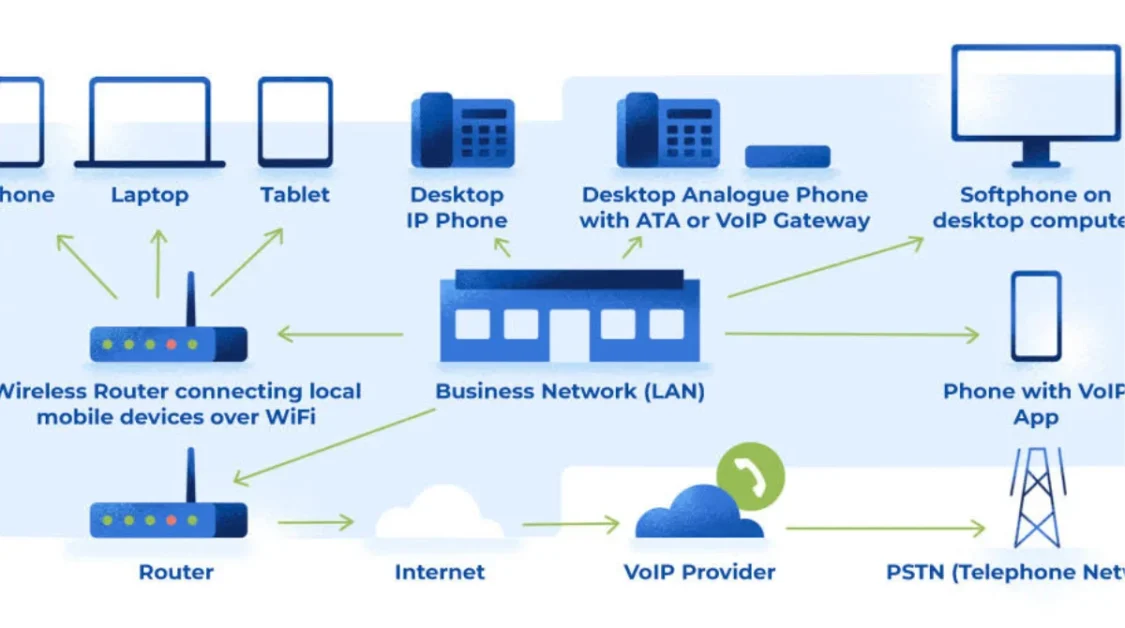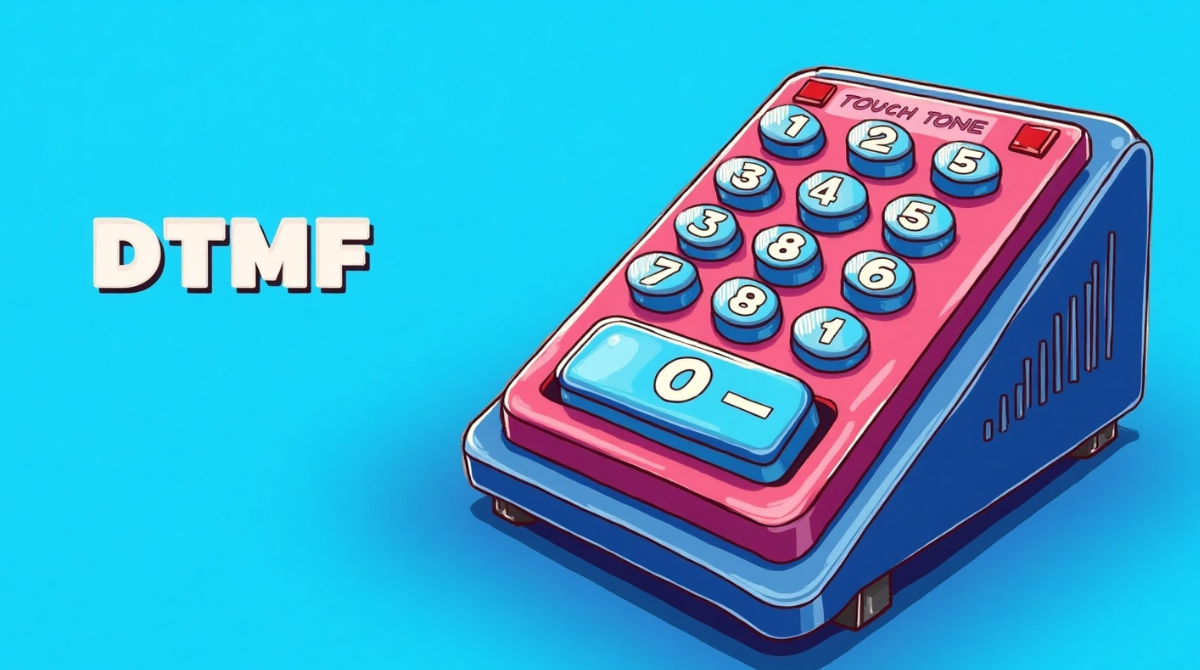What is DTMF and How Does It Work?
When you press the number keys on your phone to make a call or navigate through an automated system, the tones you hear are more than just sounds—they’re signals. These signals are made using a technology called Dual-Tone Multi-Frequency, or simply DTMF.
DTMF is a method of sending information using sound. When you press a number on your phone, it produces two tones at the same time—one low frequency and one high frequency. These two tones together help the system on the other end understand what key you pressed. This system is used in both old landline phones and in newer digital and internet-based calling systems.
Why It’s Called “Dual-Tone Multi-Frequency”
The name “Dual-Tone Multi-Frequency” describes exactly how it works. “Dual-tone” means that two tones are used at once. “Multi-frequency” means that the system has several different tones or pitches to choose from. Each key on your phone uses one tone from a low-frequency group and one tone from a high-frequency group. These unique tone combinations allow the system to identify the button you pressed.
So for example, when you press the number “5”, your phone sends out one tone from the low group and one from the high group. These two sounds play at the same time, and the device receiving the call can match the combination to the number “5”. That’s how it knows what you pressed, even if you’re miles away.
A Quick History of DTMF
Before DTMF was invented, phones used something called pulse dialing. This was the rotary dial system, where each number was sent by creating a series of clicks. For example, if you dialed “5”, the system would send five short pulses or clicks. This system worked, but it was slow and prone to errors.
Then came DTMF, introduced by Bell System in 1963 under the name “Touch-Tone.” This changed everything. It made dialing faster, smoother, and more reliable. With just a tap of a button, two tones would be sent, and the number would be recognized instantly. Touch-Tone phones became common in households and offices, replacing rotary phones over time.
Where is DTMF Used Today?
Even though we live in the age of smartphones and the internet, DTMF is still used in many places. You may not see it, but you hear it almost daily—especially when you’re interacting with a machine or automated system. Let’s look at a few common places where DTMF is still important:
1. Telephone Systems
DTMF is used every time you press a number on your phone during a call. This includes when you:
- Dial a phone number
- Enter a PIN in your voicemail
- Press keys to choose menu options when calling customer service
- The sounds you hear are DTMF tones being sent over the line.
2. Automated Menus (IVR)
When you call your bank, service provider, or any large company, you often go through an interactive voice response (IVR) system. This is where the machine says: “Press 1 for English, press 2 for Urdu,” and so on. The system listens for DTMF tones to understand your choice.
3. Remote Control Systems
DTMF is also used to control devices from far away. For example, some home security systems or garage door openers can be controlled using a regular phone. You just dial in, press a few buttons, and the system receives your commands through DTMF tones.
4. Voicemail and Mobile Phones
DTMF still works in mobile phones, especially when you’re trying to access voicemail or control certain settings using your dial pad. Even on a smartphone, those button taps produce DTMF tones that automated systems can recognize.
Use of DTMF in Ham Radio Communication
In the world of amateur radio—commonly known as ham radio—DTMF tones are used for more than just dialing. Ham radio operators often use DTMF to send commands or control devices remotely. Since ham radios can transmit voice signals across long distances, DTMF tones sent over those channels allow for reliable, non-verbal communication.
One of the most common uses of DTMF in ham radio is for controlling repeaters. A repeater is a device that receives a radio signal and rebroadcasts it to extend its range. Operators can use DTMF to:
- Turn the repeater on or off
- Switch frequency bands
- Connect to different networks or nodes (such as in EchoLink systems)
- Send identification codes
For example, if a repeater is EchoLink-enabled (a system that connects ham radios to the internet), a ham operator can press a combination of DTMF tones to connect to another station halfway across the world.
DTMF also comes in handy for selective calling. This is a system where only radios with the correct DTMF code will respond, allowing private or group conversations even when using open frequencies.
These functions make DTMF an essential tool for enhancing communication, coordination, and control within the ham radio community, especially during emergency operations or long-distance contacts.
How DTMF Works in VoIP and Digital Networks?

Modern systems like VoIP (Voice over Internet Protocol) work very differently from traditional phone lines. Instead of using analog signals, they turn voice and sound into digital data. This can sometimes cause problems for DTMF tones because they may get distorted or lost during the conversion process.
To solve this, VoIP systems use special methods to send DTMF:
- In-Band: The tone is sent along with the voice signal.
- Out-of-Band: The tone is sent separately using a digital message.
- SIP INFO or RFC 2833: Special protocols designed for sending DTMF safely over the internet.
Out-of-band methods are more reliable in digital systems because they protect the tones from being damaged or misunderstood by the network.
Benefits of DTMF (Dual-Tone Multi-Frequency)
Here are the main benefits of using DTMF in communication systems:
1:Fast and Instant Input
- When you press a key, the tone is sent immediately.
- It saves time compared to older systems like pulse dialing.
2:High Accuracy
- Each key produces a unique tone pair, which reduces the chance of wrong input.
- Systems can easily and correctly detect which button was pressed.
3:Very Easy to Use
- No special training is needed—just press numbers like you normally would on any phone.
- Works well for people of all ages and skill levels.
4:Reliable Communication
- DTMF works on landlines, mobile phones, and even VoIP networks.
- It’s a dependable way to send commands or data using sound.
5:Widely Compatible
- Many systems worldwide still support DTMF.
- It works with both old analog and new digital technologies.
6:Remote Control Capability
- You can control devices like ham radios, repeaters, and home systems from anywhere.
- DTMF lets you send commands without needing internet or special apps.
7:Supports Automation
- Used in automated systems like IVR (Interactive Voice Response), phone banking, and customer service.
- Helps businesses run smoother and serve customers faster.
8:Cost-Effective
- It’s a low-cost technology that doesn’t require new hardware or complex systems.
- Perfect for small setups as well as large systems.
Problems and Challenges with DTMF
Like any technology, DTMF has its issues—especially when used in modern digital or internet-based systems.
Tone Distortion: In VoIP or digital calls, voice compression can sometimes change the way tones sound. This makes it harder for machines to understand them.
- Network Delays: A slow internet connection can delay or cut the tones, causing wrong inputs.
- Background Noise: Loud environments or echo in the line may confuse the DTMF reader.
- Security Risks: DTMF tones can carry sensitive information, like your PIN or credit card number. If someone is recording the call, they might steal that data.
To avoid these issues, systems use extra tools like DTMF masking. This hides the tones during a call so hackers or recording devices can’t pick them up.
What is DTMF Masking?
DTMF masking is a security method used to protect sensitive information—like credit card numbers, PINs, or passwords—when entered over the phone.
Here’s how it works and why it’s important:
1. Protects Sensitive Data
When you press numbers on your phone during a call, DTMF tones are usually heard clearly.
If someone is recording the call, they can capture your private information just by listening to the tones.
2. Hides or Scrambles the Tones
DTMF masking hides the sound of these tones so no one on the call (including the agent) can hear them.
The system still receives the input, but the actual tones are muted or replaced with fake beeps.
3. Used in Secure Environments
It’s commonly used in call centers, phone banking, and customer service where users share payment or identity details.
This helps build trust and keep customer data safe.
4. Supports Compliance with Regulations
Businesses that handle sensitive information are required to follow rules like PCI-DSS (Payment Card Industry Data Security Standard).
DTMF masking helps meet these legal and industry requirements.
5. How It Works Technically
The phone system detects when a user enters a DTMF tone.
Instead of passing the sound through, it captures the tone data silently and securely in the background.
6. Improves Customer Privacy
Even if a call is being recorded, masked tones cannot be traced back to the actual numbers pressed.
This gives customers peace of mind when entering personal details.
DTMF masking keeps your private information secure during phone calls by hiding the tones from being heard or recorded, while still allowing the system to process your input safely.
Exploring the Symbolism of “DTMF” in Bad Bunny’s Lyrics
Bad Bunny’s song “DTMF” blends unique sound and powerful messaging with its lyrics. In this track, the Latin music star uses the concept of DTMF (Dual-Tone Multi-Frequency) to communicate deeper emotional connections, technological metaphors, and modern-day experiences. While DTMF in its technical form relates to the tones sent over phones, the way Bad Bunny incorporates this concept in his song offers a symbolic representation of communication, connection, and emotions in a digital age.
Future of DTMF
DTMF has been around for more than 60 years, and it’s still going strong. Even though new technology is being developed all the time, DTMF isn’t going away anytime soon. Its simplicity, speed, and compatibility keep it useful in many situations.
In the future, we may see new and more secure signaling systems, especially in places that require high-level data protection. But for most everyday uses—like navigating menus or calling services—DTMF will continue to be a key part of how we communicate with machines using sound.
Conclusion
DTMF may seem like a small part of our daily phone use, but it plays a major role in how we communicate with automated systems. From dialing numbers to navigating menus and controlling remote devices, DTMF makes communication between humans and machines quick, clear, and efficient.
Even as technology evolves and moves toward internet-based solutions like VoIP, DTMF remains a vital tool because of its simplicity, reliability, and compatibility. With added features like DTMF masking, it continues to adapt to modern security needs.
By understanding how DTMF works and where it’s used, we gain a better appreciation for the technology behind everyday tasks—proving that even the smallest tones can have a big impact.



